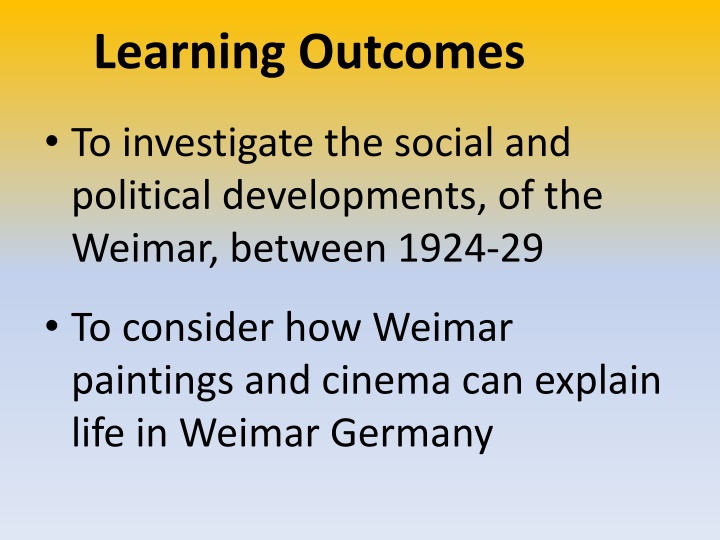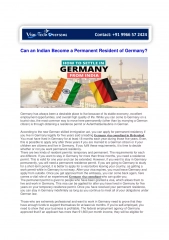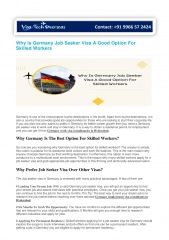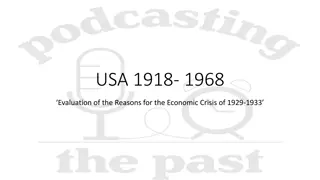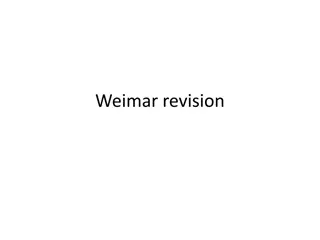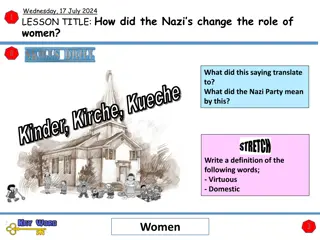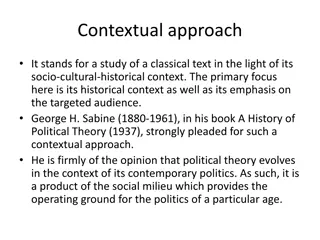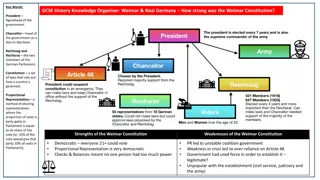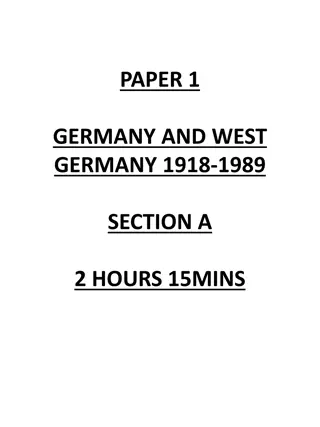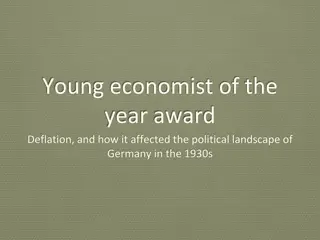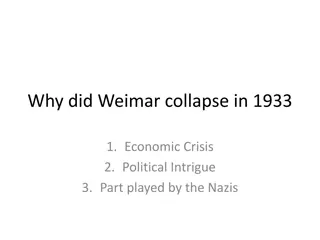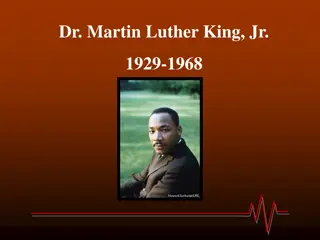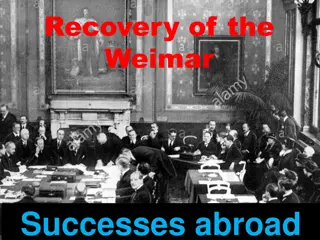Social and Political Developments in Weimar Germany (1924-1929)
The period between 1924 and 1929 in Weimar Germany witnessed greater political stability with the Social Democrats winning most of the votes, although they did not secure a majority. The election results show a decline in support for extremist groups like the Communists and Nazis. Factors contributing to this stability include economic recovery, successes abroad, the leadership of Stresemann and Hindenburg, and notable social developments such as improvements in the standard of living and the position of women.
Download Presentation

Please find below an Image/Link to download the presentation.
The content on the website is provided AS IS for your information and personal use only. It may not be sold, licensed, or shared on other websites without obtaining consent from the author.If you encounter any issues during the download, it is possible that the publisher has removed the file from their server.
You are allowed to download the files provided on this website for personal or commercial use, subject to the condition that they are used lawfully. All files are the property of their respective owners.
The content on the website is provided AS IS for your information and personal use only. It may not be sold, licensed, or shared on other websites without obtaining consent from the author.
E N D
Presentation Transcript
Learning Outcomes To investigate the social and political developments, of the Weimar, between 1924-29 To consider how Weimar paintings and cinema can explain life in Weimar Germany
Weimar Election results 1924-28 May 1924 December May 1928 1924 131 Social Democrats 100 153 National Party (DNVP) Communist Party (KPD) Nazi Party (NSDAP) 95 103 73 62 45 54 32 14 12 What can you learn about the Weimar Republic from the election results above?
The period 1924-29 saw greater political stability with the Social Democrats winning most of the votes, although still no majority! There was less support for extremist groups such as the Communist and the Nazis.
Why was there political stability between 1924-29? Economic recovery Success abroad Stresemann Hindenburg
Stresemann & Hindenburg Stresemann s successes abroad made him the most popular political leader of the Weimar Republic Hindenburg had been one of Germany s war leaders. In 1925 he was elected president, which demonstrated that the old conservative order now accepted the Republic. Image result for stresemann weimar germany Image result for President hindenburg
Social Developments The period 1924-29 is described as a golden age in the Weimar Republic due to significant changes in the standard of living, the position of women and in culture.
Standard of living Wages For many Germans these years saw an improvement in wages. By 128 there had been an increase in real wages of over 10 percent which meant Germany had some of the best paid workers in Europe. However, many of the middle classes did not share in this increased prosperity; many of them had been bankrupted by the hyperinflation of 1923. Whilst unemployment fell generally it remained high for those who worked in the professions such as lawyers.
Standard of living Housing The Weimar worked hard to deal with the housing shortage in Germany. They employed architects and planners to devise ways of reducing housing shortages. Between 1924 and 1931 more than two million new homes were built, while almost 200,000 more were renovated or expanded. By 1928 homelessness had been reduced by more than 60%
Standard of living Unemployment insurance The Weimar government created the Unemployment Insurance Law in 1927. This required workers and employees to make contributions to a national scheme for unemployment welfare. Other reforms provided benefit and assistance to war veterans, wives and dependants of the war dead, single mothers and the disabled.
The position of women Table showing women in employment in Germany between 1907 25. The figures show the percentage of the workforce that was female Type of employment Domestic servants Farm workers Industrial workers White collar and public employment Percentage of women in employment 1907 16 14.5 18.3 6.5 31.2 1925 11.4 9.2 23 12.6 35.6 What can you learn, from the table above, about changes in the employment of women in the years 1907 -25?
The position of women In 1919 women over 20 were given the vote and took an increasing interest in politics. The Weimar Constitution introduced equality in education for the sexes, equal opportunity in civil service appointments and equal pay in the professions. By 1933 there were 100,000 women teachers and 3000 doctors
Cultural changes What do we meant by culture? Art Architectures Cinema Literature
Cultural changes The Golden age of the Weimar Republic (1924-1929) saw many changes to the cultural life in Germany. There was a resurgence of creative flair that made Berlin the centre of art and culture of the world. Many new movements such as expressionism and modernism shaped the culture of the time and this is represented in, among other things, the architecture of the time.
Art Pre war censorship was removed by the Weimar government and this period saw the emergence of some of the most exciting art in Europe. Most Weimar artists tried to show everyday life commenting on the society of the time. This approach was called new objectivity and was associated with painters such as George Grosz and Otto Dix.
Architecture New architectural designs brought on by the cultural and societal ideas especially modernism These new designs challenged the traditions of architecture In 1919 Walter Gropius founded the famous Bauhaus School for architecture. At this new school Gropius taught that art should work with the new technology and that there should be an emphasis on functional design in buildings.
Architecture Architecture flourished under the Bauhaus which meant school of building . Their approach was very different from the elaborate and decorative style of pre war Germany. Their slogan was art and technology- a new unity. https://prezi.com/myya5xarl6mo/architecture- in-the-weimar-republic/
Cinema Like in art Berlin became the world leader of Cinema. In fact Germany in the 1920 s produced more films than the rest of Europe put together. This period was the home to many brilliant directors, such as Fritz Lang, Joseph von Sternberg and Ernst Lubitsch.
Cinema Metropolisposter.jpg It produced cinematic masterpieces such as Metropolis, The Cabinet of DR Caligari, Nosferatu and The Blue Angel. The film Metropolis, is acclaimed as the most technically advanced film of the decade.
Literature This period encourages literature from both the left and the right in politics: On the right, writers such as Arthur Moller were highly critical of German democracy and glorified the experiences of the first World War. On the left writers such as Ludwig Renn were very anti war. Erich Remarque wrote a moving anti war novel called All Quiet on the Western front, which describes the horrors of the First World War. All Quiet on the Western Front
Theatre Provocative theatre and Cabaret flourished Many works had a satirical edge The playwright Erwin Piscator developed the Proletarian Theatre, which produced plays that challenged the values of the traditional middle class. Another famous playwright of the time was a Marxist called Bertolt Brecht who voiced his communist opinions in his works
Task http://bp1.blogger.com/_MWG9Tm8dWe0/RpPJ_jcqK1I/AAAAAAAAAB0/vuWfHt23ySA/s320/Grosz,+Grey+Day.JPG What can you learn from this source about attitudes to the Weimar Republic?
http://bp1.blogger.com/_MWG9Tm8dWe0/RpPJ_jcqK1I/AAAAAAAAAB0/vuWfHt23ySA/s320/Grosz,+Grey+Day.JPGhttp://bp1.blogger.com/_MWG9Tm8dWe0/RpPJ_jcqK1I/AAAAAAAAAB0/vuWfHt23ySA/s320/Grosz,+Grey+Day.JPG A faceless worker A maimed soldier.; he only has one arm and has been forgotten A business man
http://bp1.blogger.com/_MWG9Tm8dWe0/RpPJ_jcqK1I/AAAAAAAAAB0/vuWfHt23ySA/s320/Grosz,+Grey+Day.JPGhttp://bp1.blogger.com/_MWG9Tm8dWe0/RpPJ_jcqK1I/AAAAAAAAAB0/vuWfHt23ySA/s320/Grosz,+Grey+Day.JPG Factory setting The badge shows that he supports the monarchy rather than the Republic The crumbling wall represents the crumbling Weimar
Image result for otto Dix big city Dix shows us the differences in classes of the people in the Weimar Republic. He is showing us the pity he feels for both the prostitutes and cripples of Germany. By placing these three different classes right next to each other, Dix is showing the variation found in the quality of life between these groups.
In he centre Dix portrays the upper class of people in the Weimar Republic. In the foreground, we see a woman in a long, ornate dress. She is wearing a lot of jewellery, which makes it obvious that she is wealthy. There is a band playing in the room and we can see a couple dancing. All of the figures in this section seem to be beautiful, carefree, and appear to be having a splendid time. By their actions, it is assumed that these people do not care at all about any other people than themselves. They are partying and seeming to have a good time while just outside, people are starving and resulting to prostitution to fill their basic human needs. .
On the left and right hand portions of, Dix has painted two scenes of crippled war veterans and prostitutes. In the right hand portion of the painting, Dix has painted high-class prostitutes. The material that their clothes are made of appears to be more expensive than the material used in the clothing of the prostitutes on the left hand side. The clothing of the women in the right hand panel displays female sexuality. Even the soldier on the right hand part of the painting looks more well to do than the soldiers on the left. He is sitting up saluting the prostitutes as they walk by him.
Low class prostitutes occupy the left hand portion of the painting. The background that Dix has painted these women on is dark and dreary. The cobblestone that they are walking on appears worn and cheap. The women are also painted under a bridge. The dog in the foreground of this portion appears to be upset and ready to attack the cripple who is attempting to move around on cheap prosthetic legs. The look on the standing cripples face is of pure lust. The other veteran in this painting is lying on the ground appearing to look up the skirt of the prostitutes that is walking by. The women have disgusted looks on their faces and appear more worn down than the prostitutes on the right hand portion of the painting. Though the group of prostitutes on the left side of the painting appears to be worse off than the ones on the right, both of these groups of women are corrupt and none of the women in either of these groups are considered respected members of society
